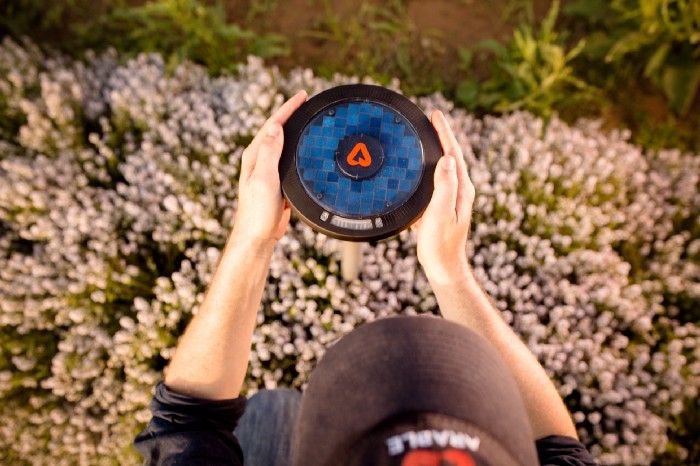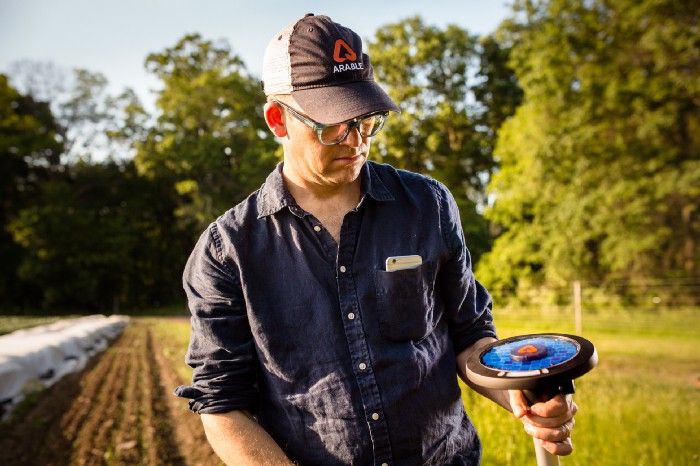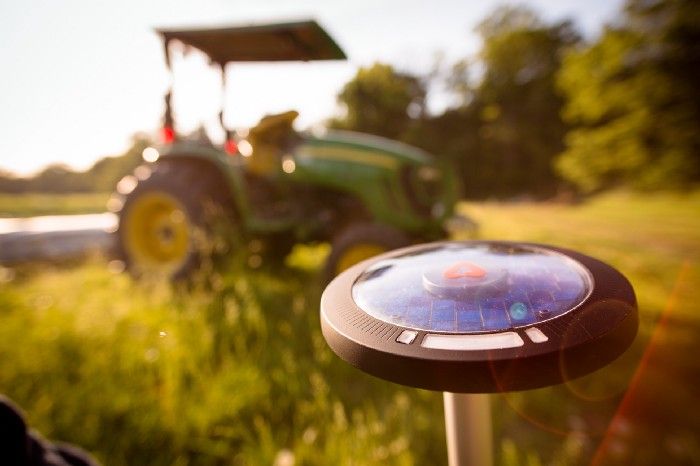Missing the Trees for the Forest
The business of prediction can be traced far back to the Delphic oracles residing at the Temple of Apollo many millennia ago. There they sat, interpreting the chants of Pythia, the Priestess, relying on her outbursts to discern everything from impending battles, seasonal drought and political outcomes. Fast forward to today, where Nate Silver has turned forecasting into a sport. Modern data science has brought the god-like art of prediction down to popular consciousness (although still stored in a cloud).
Arable’s Pulsepod is an integrated solution for data-driven land management that can reduce a farmer’s risks in real time.
As a scientist, I spent a lot of time thinking about forecasting from a plant’s view of the world – the game theory of mano-a-mano struggle for supremacy that hinges on strategies to best allocate resources in an uncertain environment, against a field of other plants trying to do the same to you. In fact, I spent the five years of my dissertation at Stanford trying to make predictions from space, only to realize that satellite images fail to move us past a superficial understanding of the model. Down on the ground there are individual agents making choices in response to perceived scarcity and their own unique strategies.
Everything I know about how plants grow, how the weather unfolds, and how farm operations are run tells me that measuring the past is the key to predicting the future, and in the future is where fortunes are made and lost.
We’ve come to see we’re in the business of certainty
Adam Wolf, CEO of Arable, with the Pulsepod.
Two of the largest challenges to certainty in agriculture and natural resource management is an over reliance on human memory and poor data quality. Memories come and go as people turn over at an institution. The other challenge that we see is bad facts: weather predictions that don’t understand microclimate, satellite data that shows patterns but not processes, incomplete observations from weather stations. Furthermore, most of these predictions are based on data that isn’t local. In agriculture, and more broadly in any natural resource management, the ability to evaluate certainty around events unfolding in real-time can provide significant insight into decision making with tremendous financial consequences. We’ve seen this happen in everything from strawberry farming to crop insurance.
A lot of money changes hands when a crop goes from tethered to a plant in the ground to something packed in a box or bottle. Specialty crops is a $50Bn industry in the US, about a quarter of the total value of arable crops, grown on just a tenth of the land. The best operations are exceptionally sophisticated in mastering the harvest, packing, transport, delivery to a willing buyer and getting those crops to market in just hours. And while most agricultural technology is oriented around chores tending crops after planting, the big opportunity is managing risk in operations and marketing before harvest.
Arable’s Pulsepod is solar powered and WiFi, Cellular and BlueTooth enabled.
Much of that depends on visibility into what is happening in the field – getting trucks to the field on time with the right number of packing crates, getting an engineer into the field to fix pipes, writing a timely prescription for plant protection, etc. That celery (or strawberries or kale or you name it) is going to show up in grocery stores across America just a day or two after it was hand-picked from a field where it was growing under the sun. If it’s not contracted by the time it’s landing in the clamshell? It may as well be compost. Picked late? Compost. Price dropped out of the market? Compost. Frost? Compost. All of this requires a shared base of knowledge that is all but nonexistent in agriculture right now.
But if it’s not compost, it’s gold: a berry grower can bring in $80K an acre. You can see why strawberries bring in $2.5Bn annually to the California economy when you start doing the math. What’s not acceptable is that bad forecasting is costing the producers about 25% of that desire for berries, because if they don’t know how much they have to sell beforehand then they don’t have time enough to sell it at the time it’s ready for harvesting. In other industries this is called “inventory management”, and it helps to coordinate when you need to (say) send more gasoline to a particular service station, as well as (say) tell the SVP of sales and marketing what the quarterly earnings are shaping up to be.
But while some industries have all kinds of gadgets to measure inventory, in agriculture there’s just one: Arable.
Learn more about Arable.


